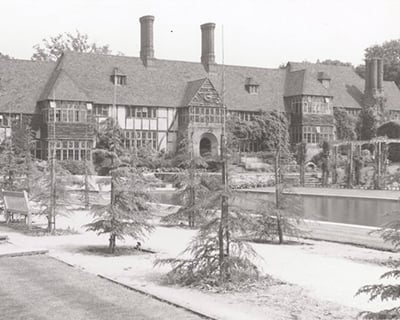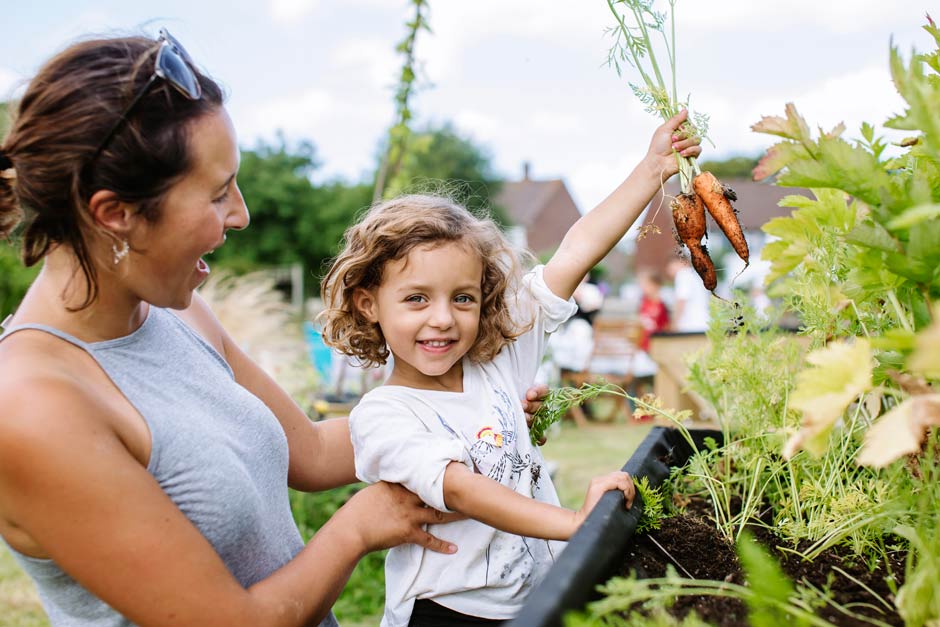The History of the Royal Horticultural Society
Discover the evolution of the RHS and how it has become the UK’s leading gardening charity
The Royal Horticultural Society (RHS) was founded on 7 March 1804 as The Horticultural Society of London, in a meeting of just seven men, including renowned plant collector and botanist Sir Joseph Banks and horticulturalist John Wedgwood. Dedicating the Society to the improvement and practice of horticulture, their aim was to introduce a scientific and evidence-based approach and to be a conduit for sharing knowledge. It was a small, learned society of enthusiasts, professional gardeners and nurserymen.
Building and sharing knowledge
The Society leased an experimental garden in Chiswick in the 1820s and started commissioning plant collectors to return specimens from around the world for cultivation and study. Many of the plants in our gardens today were introduced during this period. The commitment to extending and sharing horticultural knowledge drove the creation of the rich collections of reference books, journals, reports, artworks, herbarium, and entomological specimens that are now among the finest in the world.
Becoming a member
When the Society acquired its first formal charter in 1809, members were called Fellows. To become a Fellow, you had to be proposed and accepted at a council meeting, then pay a three guinea-joining fee and an annual subscription of two guineas. Today’s equivalent would be a £2,500 joining fee with a £1,600 annual membership charge. Fellows therefore usually came from the wealthier social classes.
Professional gardeners could also be elected as fellows with a membership called ‘Gardeners Admitted to the Privileges of Fellowship.’ It was essentially a gentlemen’s club and women were not admitted until 1830. Honorary Fellowships were offered to the monarchs of Europe. Fellows were entitled to copies of the Society’s lavishly illustrated journals (Transactions), visits to the RHS Chiswick Garden and plants and seeds from its plant-collecting expeditions.
Royal connections and the Royal Charter
In 1858 Prince Albert became the RHS President and from 1861 the Society got its Royal Charter and a fashionable new garden. Between 1861–1888 the main RHS garden sat in the heart of South Kensington, London, which today is the location of the Science Museum.
The late Queen Elizabeth II became the Patron of the RHS in 1952, on the death of her father, King George VI, carrying on the dynastic association with the RHS, which had begun in Victorian times. She performed the role alongside the late Queen Elizabeth, The Queen Mother, who was Patron of the RHS for 65 years.
In 2024 King Charles III was announced as the new RHS Patron.
The RHS erected the purpose-built Lindley Hall, a library, and offices in Pimlico and, due to the popularity of its bi-weekly flower shows, added Lawrence Hall in 1928.
A growing membership
By 1900, there were 5,000 fellows and by the outbreak of the Second World War, 30,000. Membership continued to grow reaching 50,000 in 1956.
In 1978, fellows became members and the membership opened to everyone with an annual fee of £7.50. By 1982, it was at 82,000 but with a quarter living in Surrey. There were more RHS members living in the USA than in Scotland. The six northern counties had fewer than 300 members each.
RHS Shows
At the Society’s regular meetings, Fellows read papers and exhibited interesting plants that were often new to British horticulture. The first-ever exhibit was a potato. In the 1820s, the Society then began running outdoor flower shows at its garden in Chiswick. The annual Spring Fete became a major event in the London social calendar. In 1913, the Society moved its annual Great Spring Show to the grounds of the Royal Hospital in Chelsea, where it has remained ever since, becoming the world-famous RHS Chelsea Flower Show. In 1993, the Society took over the RHS Hampton Court Flower Show, which it continues to run annually to this day (as the RHS Hampton Court Palace Garden Festival) alongside RHS Flower Show Tatton Park, and co-hosts RHS Malvern Spring Festival. In April 2024 the first RHS Urban Show in Manchester will take place.
RHS Garden Wisley
In 1878 Sir George Fergusson Wilson bought Oakwood in the village of Wisley. He was a gardener renowned for experiments and trials, and when he died, Sir Thomas Hanbury bought it, and the adjoining farm. In 1903 Hanbury, following the advice of fellow horticulturalist Ellen Wilmott, gifted Oakwood to the RHS who had been seeking, ‘a garden beyond the range of the London smoke’.
In its first year, Wisley received 6,000 visits. Today this figure stands at more than one million. The Laboratory and School of Horticulture were established at Wisley in 1907, to support the scientific and educational remit that Sir Thomas had specified in the transfer of deeds. The very first ‘Award of Garden Merit’ was given here in 1922 for the plant Hamamelis mollis. In 1936, the Portsmouth Field next to Wisley was purchased and is now known as Battleston Hill.
RHS Garden Rosemoor
The RHS grew and in 1988 gained their second of today’s RHS gardens when Lady Anne Berry (formally Palmer) gifted her eight-acre garden Rosemoor, in Devon, which included 32 acres of pasture. She’d established a collection of rare and unusual trees, many of which she’d grown from seed. Wisley was Anne’s inspiration. She wanted to establish a place where rare and interesting plants could be grown in favourable conditions. Devon, with its mild climate, was perfect. Designer Elizabeth Banks helped her and went on to become the first RHS female President from 2010 to 2013.
RHS Garden Hyde Hall
Hyde Hall, Essex was a working farm when bought by Dick and Helen Robinson in 1955. They’d returned from Trinidad, where they’d helped run a citrus farm. The Essex farmhouse had 340 acres of farmland but not much garden. The Robinsons transformed it from wasteland to a paradise and when they retired in 1976, set up the Hyde Hall Trust to maintain its future. In 1993 the trust donated the garden to the RHS, making it today’s third garden.
RHS Garden Harlow Carr
In 2001, the RHS merged with the Northern Horticultural Society at Harlow Carr, Yorkshire to form the fourth garden. The Northern Horticultural Society was formed in 1946 and leased 26 acres of mixed woodland, pasture and arable land, which was once part of the Forest of Knaresborough, an ancient Royal hunting ground at Harlow Hill. They opened the Harlow Carr Botanical Gardens in 1950 to set up a trial ground to assess the suitability of growing plants in northern climates.
RHS Garden Bridgewater
Bridgewater, Salford, the newest of the RHS Gardens, opened in 2021. Worsley New Hall was a notable residence of its era, once visited by Queen Victoria and King Edward VII. It survived a fire and two World Wars before it was demolished in the 1940s.
Built for the 1st Earl of Ellesmere between 1840 and 1845, the grand Gothic-style mansion was designed by the architect Edward Blore – whose speciality was Tudor and Elizabethan-style architecture. From 1846 William Andrews Nesfield, one of the most sought-after Landscape Designers of the time worked on the gardens and they were then landscaped over a 50-year period.
Worsley New Hall became a British Red Cross hospital during the First World War and with the departure of the Egerton family, the hall and the gardens fell into decline. In the Second World War parts were requisitioned by the War Office and the gardens used as training grounds by the Lancashire Fusiliers.
Weakened by dry rot and following a fire in 1943, the once-grand building was demolished. In the intervening years the grounds were used as a nursery, a garden centre, a Scout camp, an indoor rifle range and a fishing lake.
The RHS, Peel Land and Property, and Salford City Council collaborated to create a brand-new RHS garden. Full planning permission was granted in June 2017 and the revival of the gardens of the historic 154-acre Worsley New Hall estate, to create RHS Garden Bridgewater, represented one of the largest gardening projects in Europe at this time. RHS Bridgewater opened in May 2021.
Charitable purpose
The original mission back in 1804 was ‘the encouragement and improvement of the science, art and practice of horticulture in all its branches’. Today it remains the same, with numerous community engagement programmes that aim to spread the benefits across the whole of the country, such as Britain in Bloom and the Campaign for School Gardening.
The 2020 Science Strategy was published to try and meet the challenges of a changing climate with key principles of promoting plant health, planet friendly gardening, gardening for wellbeing and the promotion of plant diversity.
In 2023, the RHS joined with the Government and other charities to implement the National Education Nature Park programme, which encourages nationwide gardening and
A sustainable future
Building on its history, the RHS of today is using its unique position as the UK’s leading gardening charity to create a more sustainable future for people and the planet. The Sustainability Strategy was launched in September 2021 and in May 2023 the RHS launched the overarching RHS Strategy which outlined five key shifts: to be more urban, involve more young people, support more beginners, garden more sustainably and to go more digital.
Digital developments include the RHS Grow app, an AI online advice tool ChatBotanist, the online Digital Collections, with hundreds of historical images and archives from the RHS Libraries including the RHS Herbarium, the largest herbarium dedicated to ornamental plants in the UK.
What began as a small organisation for a few, the RHS of 2024 is focusing on opening up gardening for anyone, anywhere. The RHS has a long and varied history, but the goal is to have a long-lasting and sustainable future that firmly places gardening at the heart of the lives of all.



